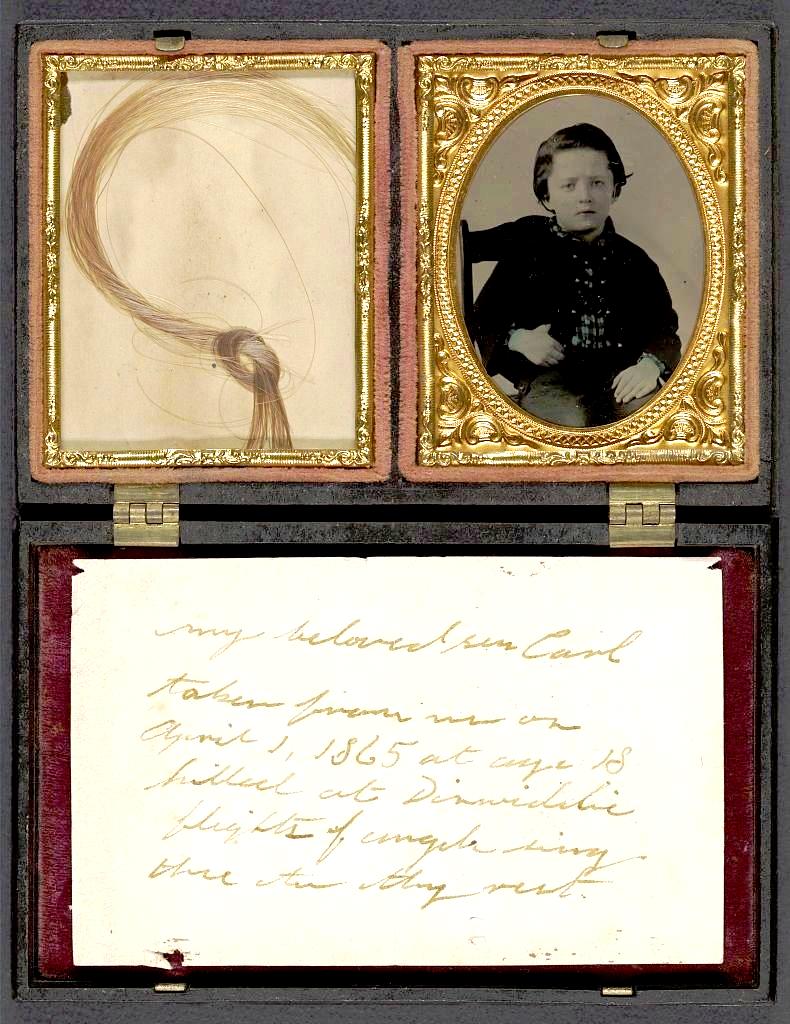
American Civil War Campaigns--Battle of Five Forks (April 1, 1865)

Figure 1.-This unique three compsrtment cased Ambro shows the boyhood image along with a lock of his hair. His namewas Carl. The Ambro would have been taken about 1855. Carl was killed woulded at the Battle of Dinwiddle Court House March 31) and died the next day. We do not have his last name. He was 18 years old. The message reads something like, "my beloved son Carl, taken from me on April 1, 1865 at age 18 killed at Dinwiddle< flights of angels sing thee after they rest."
|
|
It was the the Battle of Five Forks (April 1, 1865) that finally broke the stalemate before the Confederate lines defending Richmond and Petersburg (April 1, 1865). Five Forks as the name suggests was an important road junction southwest of Petersburg, in Dinwiddie County. A mobile Federal task force consisting of infantry, artillery and cavalry commanded by Major General Philip Sheridan defeated a Confederate force. Sheridan was the principal Dederal calvalry commander. For the first 3 years of the War, the Cofederate caklvalry reguklarly outfought and out manuvered the Federals. This seems to have reflected the stronger militia groups in the south and superior horsemanship, As the War progressed, attrition and superior Federal resources changed this. The Henry repeating rifle was an important factor. The turning point was Gettsburg (July 1963). Gen. John Buford's 1st Calvalry Division played a key role on the first day at Gettysburg while J.E.B. Stuart's calvalry force was not only of no aid to Lee, but suffered a major defeat. By 1865, the Federal Calvalry was an extroidinary fighting force and the Confederate calvalry lrgely ineffective. And the Federal calvalry played a key role in forcing lee to surrender the Army of Northern Virgina, essentislly ending the War. Sheridan mastermined the Federal Shenandoah campaign denying Lee supplies from the west. Grant's seige cut off Richmond from the north and east. Only supplies from the south kept the Army of Northern Virginia supplied. Grant ordered Sheridan to sever Lee's final supply lines south of Pertersburg. Lee understnding the danger struck back. He ordered Major General George Pickett to drive the Federals from Five Forks. Pickett of course is best known for his failed charge at the Federal center at Gettysburg. It should be stressed that the charge was Lee's idea, Pickett only dutifully carried it out. After Gettysburg, Pickett played a valiant and competent role in the last 2 years of the War. Two battles were fought leading to Five Forks: White Oak Road and Dinwiddie Court House (March 31). Pivkett achieved some success at first, but ultimately sustsanined unreplaceables losses (1,000 casualties and about 3,000 prisoners). Sheridan's force seized Five Forks severing the South Side Railroad, the vital Confederate supply line and only rail retreat line from Petersburg and Richmond.
HBC

Navigate the CIH Civil War Section:
[Return to Main Civil War campaign page]
[Biographies]
[Campaign]
[Causes]
[Emancipation]
[Families and youth]
[Fiscal policy]
[Formations and units]
[Law]
[Railroads]
[Slavery]
[Soldiers]
[Uniforms]
[Weaponry]
[Lost Cause]
[Civil Rights movement]
[Return to the Main Civil War page]
Created: 11:56 PM 6/6/2018
Last updated: 11:56 PM 6/6/2018



